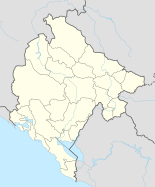Perast
|
Perast Пераст |
||||
|
||||
| Basic data | ||||
|---|---|---|---|---|
| State : |
|
|||
| Municipality : | Kotor | |||
| Coordinates : | 42 ° 29 ' N , 18 ° 42' E | |||
| Height : | 6 m. i. J. | |||
| Residents : | 349 (2003) | |||
| Telephone code : | (+382) 082 | |||
| Postal code : | 85336 | |||
| License plate : | KO | |||
| Structure and administration | ||||
| Website : | ||||
Perast ( Cyrillic Пераст ; Italian Perasto ) is a small town in Montenegro belonging to the municipality of Kotor . It is located below St. Elias Mountain (873 m) on the shores of the Bay of Kotor and there is the place with the mildest climate and the most hours of sunshine per year. Perast is connected to Risan in the north and Kotor in the southeast via the coastal road on the bay .
The two small islands of St. George ( Sveti Đorđe ) and St. Mary on the Rock ( Gospa od Škrpjela ) belong to Perast . The town's cemetery is on one island, the other with its chapel is a well-known place of pilgrimage.
In the Middle Ages, Perast and the other places on the bay were disputed between the local principalities ( Zeta , Bosnia ) and the Republic of Venice , and ownership changed frequently. The place was the first on the bay to voluntarily protect itself from the Republic of St. Mark. Because many residents had served the Venetians in the fleet of the republic particularly loyally, the Signoria gave the small town in 1368 the sonorous title of "Fedelissima Gonfaloniera" (Most Faithful Standard Bearer) .
The old Perast had no city wall, but was protected by nine individual towers. These were built in the 15th and 16th centuries to protect against the Ottomans , after the place came under the rule of the Venetians again in 1420. After the end of the Turkish Wars, Perast had its heyday in the 18th century. There were four shipping companies in the village, which together maintained a fleet of more than 100 merchant ships. Many of the captains who had become prosperous chose Perast as their retirement home and built smaller or larger villas that still shape today's cityscape. At the end of the 18th century, Perast had more than 1,600 inhabitants. When the Venetian rule ended with the defeat of the republic in 1797, the inhabitants regretted this very much, because they had always had a good relationship with the Republic of Mark.
In the 19th century the place lost its importance and the number of inhabitants sank to 430 by 1910. Today 349 inhabitants live in Perast (2003).
The town's orthodox church is well worth a visit, with a small exhibition of relics , liturgical objects and jewelry.
literature
- Giuseppe Gelcich: Memorie storiche sulle bocche di Cattaro . Zara 1880.
- Goran Ž. Komar: Boka Kotorska. Kulturno-istorijski vodič . Beograd 2002. ISBN 86-83727-10-6 .
- Borivoje Ž. Milojević: Boka Kotorska (Regionalno-geografska) . In: Zbornik radova (Journal of the Geographical Inst. Of the Serbian Academy of Science) , born in 1953, pp. 1–52.
- Branko Sbutega , Gracija Brajković: Mary of the Rock. Perast . (Tourist guide). Zagreb 1988.
- Ivo Stjepčević: Guide to Kotor (Cattaro) and the Bocche. Hercegnovi and Kotor 1927.
- Francesco Viscovich: Storia di Perasto (Raccolta di Notes e Documenti) dalla caduta della repubblica Veneta al ritorno degli Austriaci . Trieste 1898.
Web links
- Tourist website on Perast (English)


